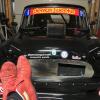Hi,
I have an '89 Mini Racing (998cc) with the John Cooper conversion kit offered at the time (twin SU carbs). The car has had a lot of cosmetic modifications but mechanically it's pretty much the same as it has always been.
A few days ago I noticed that on depressing the brake pedal, the engine revs increased substantially. The brake pedal also seemed very firm and brake performance poor.
Had a poke around under the bonnet and noticed that the hose between the brake servo and the manifold seemed to be working lose at the manifold end, so I tightened it up.
Now when I press the brake pedal, the revs drop and the engine stalls. The brake pedal still seems overly firm and I suspect that brake performance is as poor as it was when the problem was noticed (I haven't driven the car since noticing the original problem).
I've tried starting the engine with the brake pedal depressed and the pedal doesn't "drop" a little as I'd expect it to. There's no obvious hissing from any components.
My assumption at this stage is that I have a problem with the hose, the non-return valve or the servo itself (or any combination of those three items).
Before I start spending money on replacement components has anyone any ideas on narrowing down the problem? Or any suggestions for the root of the problem that I haven't considered?
Thanks
Will.















